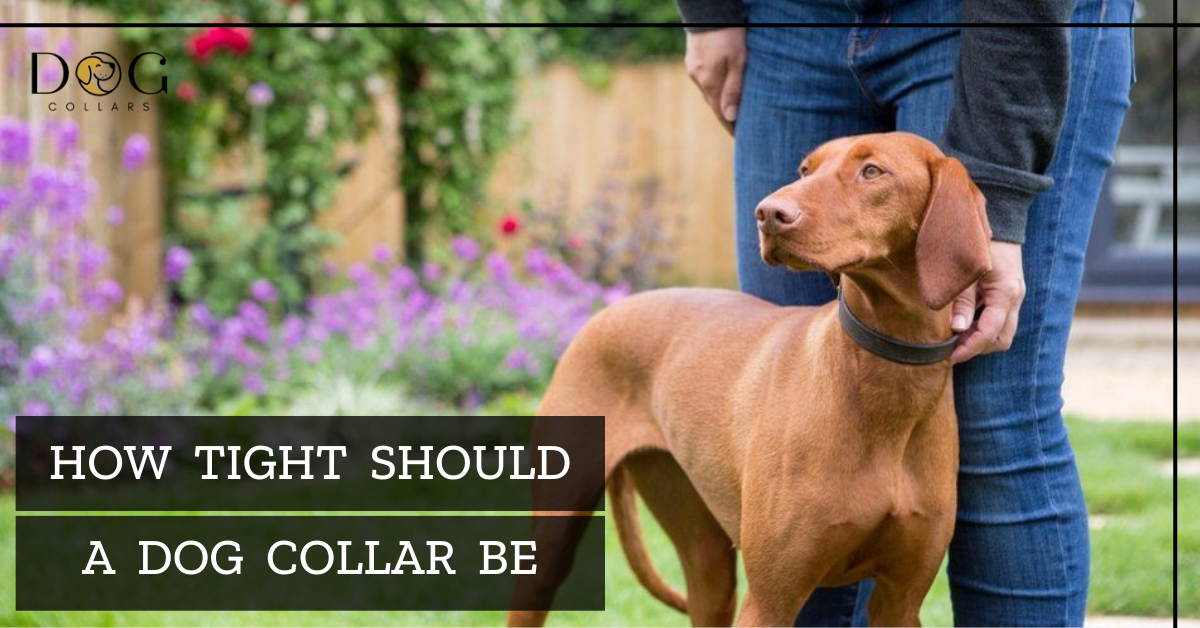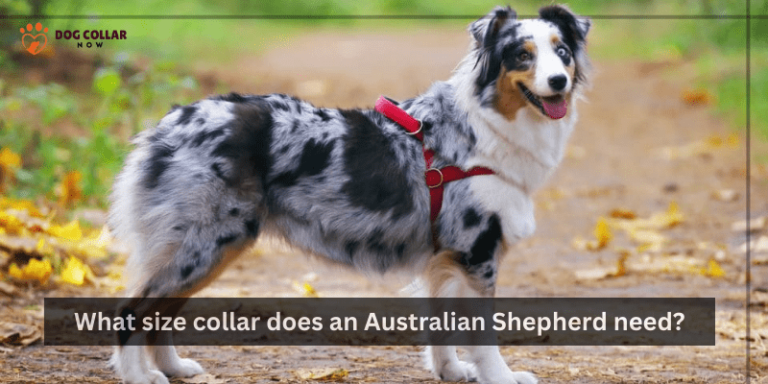How Tight Should A Dog Collar Be – A Detailed Guide

Dog collars are an essential accessory for pet owners, providing a means to attach identification tags and pets wear a collar to keep dogs under control during walks or training sessions. Your furry friend’s collar is not just a stylish accessory, but it’s also an essential tool for their safety. However, finding the right fit can be challenging.
As a dog owner, you know that keeping your furry friend safe and comfortable is a top priority. One aspect of this is ensuring that your dog’s head collar fits properly. An ill-fitting collar can lead to discomfort, irritation, and even health risks. A collar that’s too tight can make it difficult for your dog to breathe, cause skin irritation,
To ensure a proper fitted collar for your dog, measure their neck and add a comfortable length. Leave a gap of two fingers’ width between the collar and their neck, regularly check the fit, and adjust as needed for their safety and comfort.
In this blog post, we’ll dive deeper into the importance of getting the right fit for your pet’s collar and help you find the perfect balance between safety and comfort for your furry companion.
Looking for the Best Shock Collar for Large Dogs?
Tell us your dog’s breed and neck size, and we’ll help you find the best shock collar on Amazon!
How Tight Should A Dog Collar Be
When it comes to fitting your dog’s collar, you want to ensure that it’s not too tight or too loose. A perfect fit collar or dog harness should be snug enough to prevent slipping, but not so tight that it causes discomfort or restricts breathing. A good rule of thumb is to leave a gap of about two fingers’ width between the collar and your pet’s neck.
Regularly check the collar fit and make adjustments as necessary to ensure that it remains comfortable and secure. By fitting your dog’s collar just right, you can help keep them safe and happy!
Two-Finger Rule
The two-finger rule is a helpful guideline for fitting your pet’s collar. The rule suggests leaving a gap of about two fingers’ width between the collar and neck to ensure a comfortable and secure fit.
This allows enough room for your dog to breathe and move comfortably, while also preventing the collar from slipping off. Remember to regularly check the collar fit and make adjustments as necessary to ensure that it remains comfortable and secure. By following the two-finger rule and fitting your collar just right, you can help keep them happy, healthy, and safe.
According to Dr. Jennifer Coates, the two-finger rule is a simple and effective way to ensure a proper fitted choker for your dog. Dr. Coates explains that leaving a gap of about two fingers between the collar and neck allows for enough room for your dog to breathe and move comfortably, while also preventing the collar from slipping off.
Factors to Consider When Fitting a Dog’s Collar
Size:
Measure your dog collar and the pup’s neck and add an appropriate length for comfort and the right size. A good rule of thumb is to add about two fingers’ worth of space between the collar and your dog’s neck.
Width:
The width of the collar should also be considered. A wide collar is suitable for larger dogs, while a narrow collar is better for smaller dogs.
Material:
Collars come in various materials, such as nylon, leather, and neoprene. Consider your dog’s lifestyle and choose a material that is durable and comfortable for them.
Purpose:
The purpose of the collar should also be considered. If you plan on walking your dog at night, consider a reflective collar. If your dog is a puller, consider a harness instead of a collar.
Allergies:
If your dog has sensitive skin or allergies, choose a hypoallergenic collar to prevent any discomfort or irritation.
Adjustability:
It’s important to regularly check collar fit and make adjustments as necessary to ensure that it remains comfortable and secure. By considering these factors and taking the time to properly fit your collar, you can help keep your furry friend happy, healthy, and safe.
How to Measure for a Dog Collar fit?
When it comes to getting the right collar for your dog, measuring correctly is key. To measure your dog’s neck, take a soft tape measure and wrap it around the neck where the collar would sit. Make sure you can fit two fingers under the tape measure without it being too tight or too loose.
It’s important to note that different types of collars will require slightly different measurements. For example, if you’re opting for a martingale collar, you’ll need to add an extra inch or so to ensure there is enough slack when not in use.
If your dog is still growing or in between sizes, opt for an adjustable collar that can be easily resized as needed. Avoid purchasing a collar solely based on breed averages as every dog has unique body proportions.
When measuring for a new collar, always double-check measurements before making any purchases. A properly fitting collar should be snug but not restrictive and allow room for growth or adjustment over time.
Signs that dog’s collar is too tight
One of the most apparent signs of an ill-fitting collar is when a dog tries to remove it by scratching excessively around its neck area or pulling at the leash. This could indicate that the collar is either too tight or too loose around your dog’s neck.
Another sign of a poorly fitting collar is your dog may suffer from skin irritation and hair loss on your pet’s neck due to rubbing against the edges of the collar. The same goes for collars made from materials like nylon which can be abrasive over time causing serious injuries in some cases.
Additionally, if you notice any changes in your dog’s behavior such as whimpering while wearing a new or existing collar then this may suggest that it feels uncomfortable wearing one altogether.
Keeping an eye out for these warning signs will help you identify whether your dog’s current collars are appropriately sized or need replacement with better-suited options. It’s important always to check and adjust any collars according to changes in weight gain/loss throughout life stages ensuring that they remain comfortable!
Why a Properly Fitting Collar is Important
A proper fit collar ensures that your furry friend is comfortable and safe while wearing it. It also prevents any potential accidents from occurring such as choking, skin irritation, or cutting off circulation to vital organs.
By taking the time to measure your dog’s neck and choosing the correct type of choker, you can ensure that they are safe and secure at all times. Remember to check regularly if their existing collar still fits them properly, especially during puppyhood when they grow at an exponential rate.
In summary, whether you choose a flat, training or harness style for your pet’s comfort and safety shouldn’t be taken lightly knowing how tight should your pup’s collar be., will go a long way in keeping them healthy and happy for years to come!
Types of Dog Collars
There are different types of dog collars available for dogs, each with its own unique design and purpose. The type of neckband you choose will depend on your dog’s individual needs and preferences.
One popular type is the flat collar, which is simple in design and commonly used for everyday wear.
Another option is the leather collar or martingale collar, which has an adjustable loop that tightens when pulled but prevents over-tightening. This can be helpful for breeds with narrow heads or those prone to slipping out of their collars.
For training purposes, a head halter may be beneficial as it gently guides the dog’s head in the desired direction without causing discomfort. We should only use a choke chain or prong collar under the guidance of a professional trainer as they require a proper technique to avoid injury.
No matter what type you choose, ensuring it fits properly and does not cause discomfort or harm to your furry friend should always be a top priority.
Conclusion
In conclusion, finding the right fit for your dog’s collar is essential to ensure their safety and comfort. A collar that is too loose can slip off, while a collar that is too tight can cause discomfort or even injury.
As a general rule, you should be able to fit two fingers between your dog’s neck and the collar. However, it’s important to check the fit of the collar regularly and adjust as necessary, especially as your dog grows or gains/loses weight.
Remember to monitor your dog also for any signs of collar chafing or irritation and make adjustments as needed. By taking the time to find the right fit for your dog’s collar, you can help ensure their well-being and happiness.
FAQs
How do I know if my dogs collar is to tight?
If your dog’s collar is too tight, you may notice signs such as difficulty breathing, excessive scratching or rubbing, or unusual behavior such as trying to remove the collar.
How loose or tight should a dog collar be?
A dog collar should be snug but not too tight, allowing you to fit two fingers between the collar and your dog’s neck. This ensures a comfortable and secure fit while preventing the collar from slipping off.
How tight should a dog cone be?
A dog cone should be snug enough to prevent the dog from reaching the affected area but loose enough to allow for comfortable breathing and eating. It’s important to check the fit of the cone regularly and make adjustments as necessary to ensure your dog’s comfort and safety.






